9.1 Clastic Sedimentary Rocks
How Clastic Sediments Become Sedimentary Rocks
Lithification (Figure 9.3) is the process of converting sediments into solid rock. Compaction is the first step. Sediments that have been deposited are buried when more and more sediments accumulate above them. The weight of the overlying sediments pushes the clasts together, closing up some of the pore spaces (the gaps between grains) and forcing them together. Pore spaces often contain water (although they can also contain air or even hydrocarbons), so the water is squeezed out.
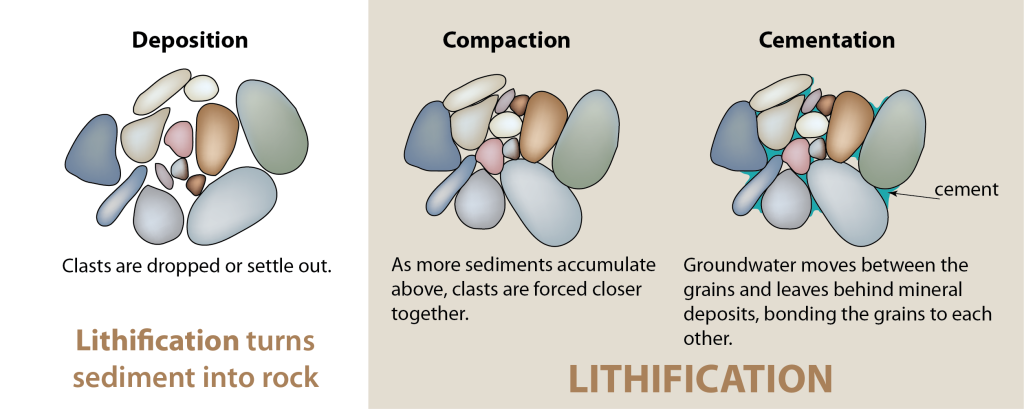
Cementation is the next step. Groundwater flowing through the remaining pore spaces contains ions, and these ions may precipitate, leaving behind minerals in the pore spaces. These minerals bind the grains together, and are referred to collectively as cement. Quartz and calcite are common cement minerals, but depending on pressure, temperature, and chemical conditions, cement might also include other minerals such as hematite and clay.
Figure 9.4 shows sandstone viewed under a microscope. The grains are all quartz but they appear different shades of grey because they are being viewed through cross-polarized light. It is difficult to tell the grains from the cement in this case because both are made of quartz, but in the image on the right the more obvious grain boundaries are marked with dashed lines. Some of the cement is marked with blue shading. Using the image on the right, see if you can pick out the grain boundaries in the image on the left.
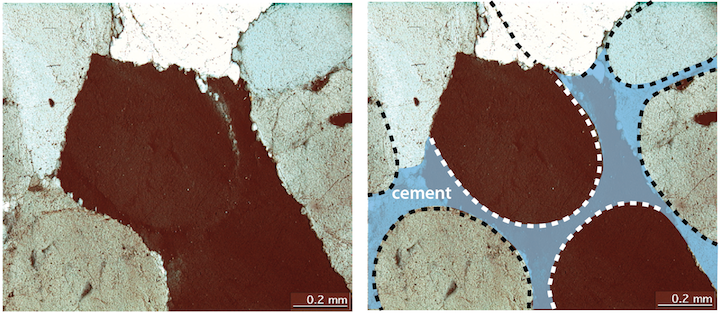
Types of Clastic Sedimentary Rocks
Clastic sedimentary rocks are named according to the characteristics of clasts (rock and mineral fragments) that comprise them. These characteristics include grain size, shape, and sorting. The different types of clastic sedimentary rocks are summarized in Figure 9.5.
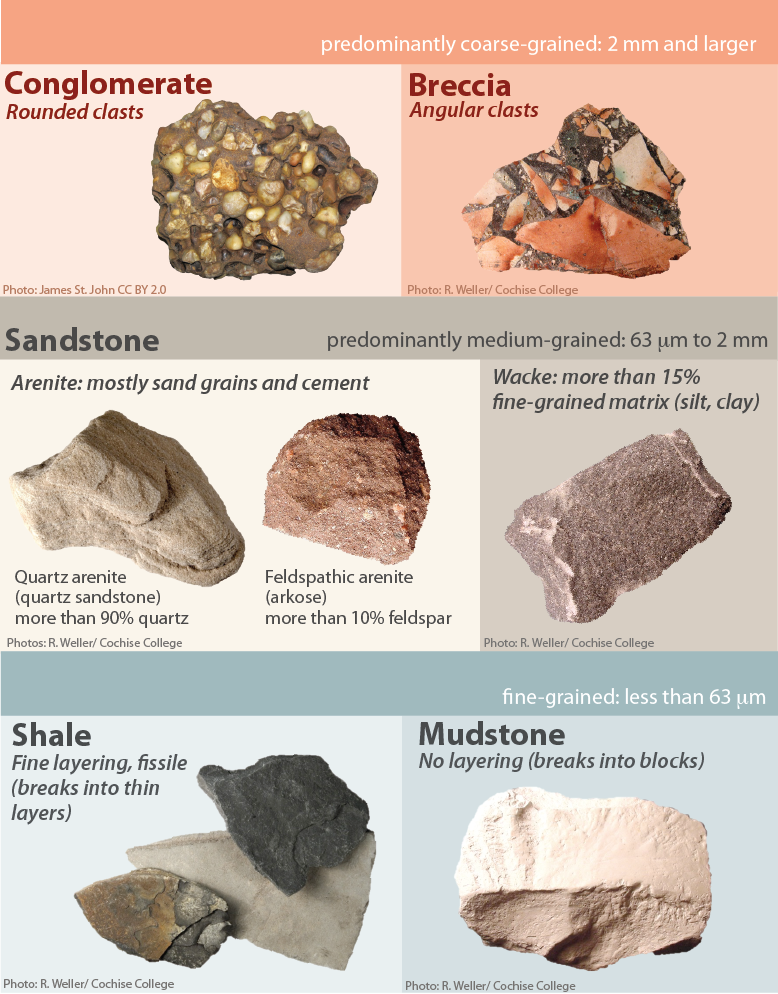
Coarse-Grained Clastic Rocks
Clastic sedimentary rocks in which a significant proportion of the clasts are larger than 2 mm are known as conglomerate if the clasts are well rounded, or breccia if they are angular (Figure 9.5, top row). Conglomerates form in high-energy environments, such as fast-flowing rivers, where the particles can become rounded as they bump into each other while being carried along. Breccias typically form where the particles are not transported a significant distance, such as in alluvial fans and talus slopes.
Medium-Grained Clastic Rocks
Sandstone (Figure 9.5, middle row) is a very common sedimentary rock, and there are many different kinds of sandstone. It is worth knowing something about the different types because they are organized according to characteristics that are useful for the detective work of figuring out what conditions led to the formation of a particular sandstone. Broadly, sandstones can be divided into two groups: arenite and wacke (rhymes with tacky).
Arenite is “clean” sandstone consisting mostly of sand-sized grains and cement, with less than 15% of fine-grained silt and clay in the matrix (the material between the sand-sized grains). Arenites are subdivided according to what the sand-sized grains are made of (Figure 9.6). If 90% or more of the grains are quartz, then the sandstone is called a quartz arenite (also called a quartz sandstone). If more than 10% of the grains are feldspar and more of the grains are feldspar than fragments of other rocks (lithic[1] fragments) then the sandstone is called an arkosic arenite, or just arkose. If the rock has more than 10% rock fragments, and more rock fragments than feldspar, it is lithic arenite.
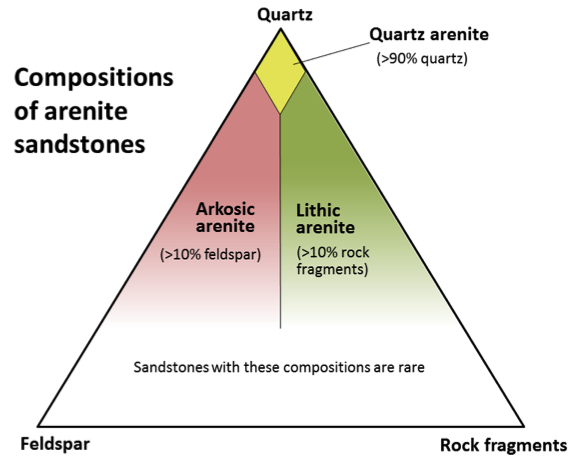
Wacke is a “dirty” sandstone, containing 15-75% fine-grained particles (clay, silt) in its matrix. A wacke can have more fine-grained particles than cement in its matrix, making for a crumbly rock. Wackes are subdivided in the same way that arenites are: quartz wacke, feldspathic wacke, and lithic wacke. Another name for a lithic wacke is greywacke.
Figure 9.7 shows thin sections[2] (microscopic views) of quartz arenite, arkose, and lithic wacke. In the images, quartz grains are marked Q, feldspar grains are marked F, and lithic fragments are marked L. Notice the relative abundances of each component in the three types of rocks.

Fine-Grained Clastic Rocks
Rock composed of at least 75% silt- and clay-sized clasts is called mudrock (Figure 9.5, bottom row). If a mudrock shows evidence of fine layers (laminations) and breaks into sheets, it is called shale. Otherwise, it is siltstone (dominated by silt), mudstone (a mix of silt and clay), or claystone (dominated by clay). The fine-grained nature of mudrocks tells us that they form in very low energy environments, such as lakes, flood plains, and the deep ocean.
Exercise: Classifying Sandstones
Use Figures 9.6 and 9.7 to give the appropriate name to the sandstone in each of the magnified thin sections shown below.
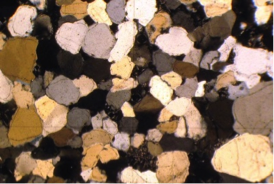 |
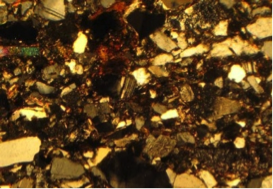 |
| Sandstone 1. Rounded sand-sized grains are approximately 99% quartz and 1% feldspar. Silt and clay make up less than 2% of the rock. | Sandstone 2. Angular sand-sized grains are approximately 70% quartz, 20% lithic fragments, and 10% feldspar. Silt and clay make up ~20% of the rock. |
Clastic sediments are deposited in a wide range of environments, including from melting glaciers, slope failures, rivers (both fast and slow flowing), lakes, deltas, and ocean environments (both shallow and deep). Depending on the grain size in particular, they may eventually form into rocks ranging from mudstone to breccia and conglomerate. By examining clastic sedimentary rocks it is possible to translate the classification you have just learned into an interpretation of the environment in which the rocks were deposited.
Sediment Maturity
Maturity in sediments refers to the extent to which sediment characteristics reflect prolonged weathering and transport. Prolonged weathering and transport cause clasts to become smaller, rounder, and more well-sorted. It removes minerals that are more susceptible to weathering, such as feldspar, leaving a sediment consisting predominantly of quartz or clay. On the spectrum of sediment maturity, quartz sandstone or shale would be mature sedimentary rocks, and wacke or conglomerate would be an immature rocks.

